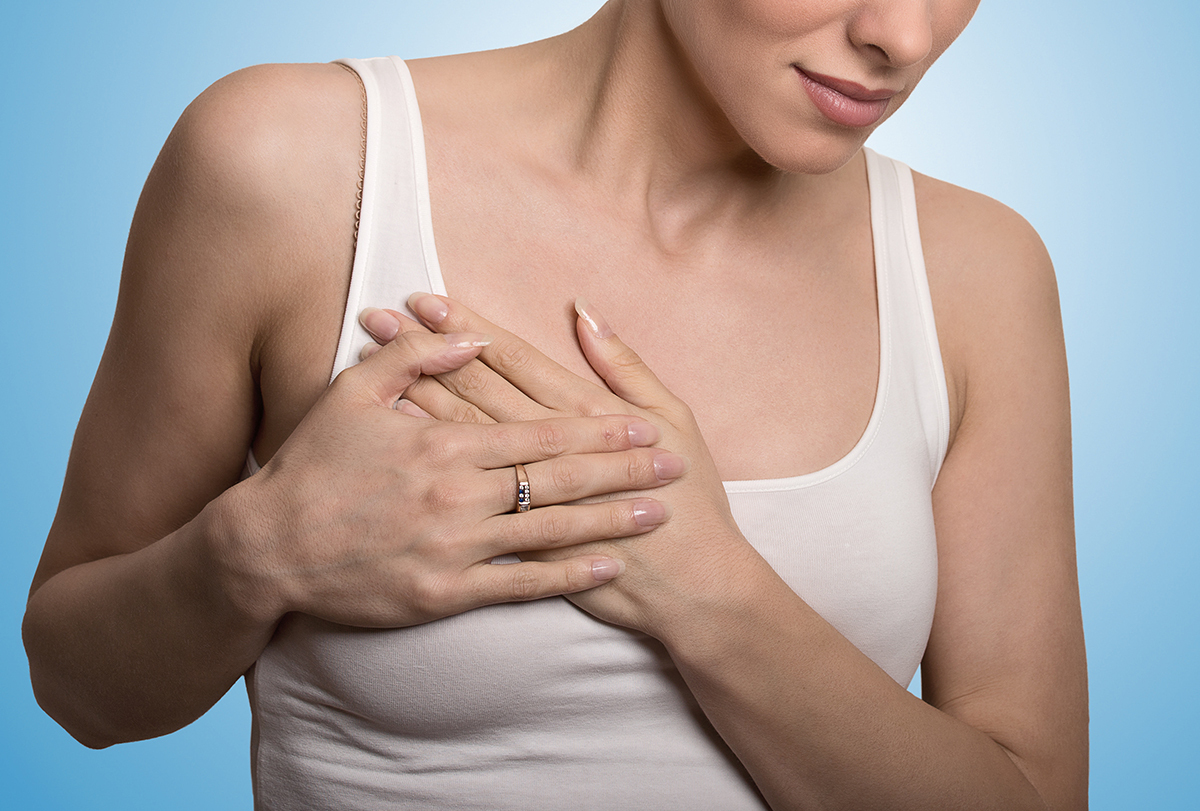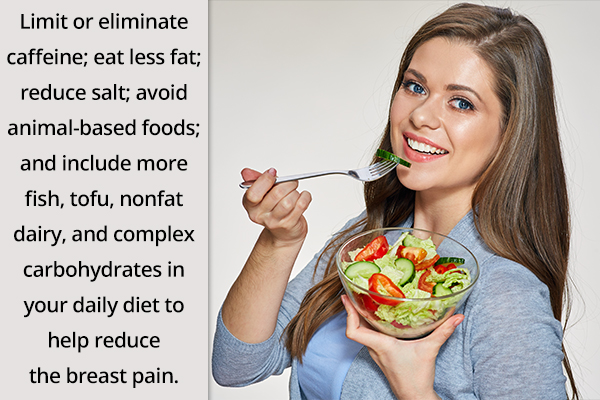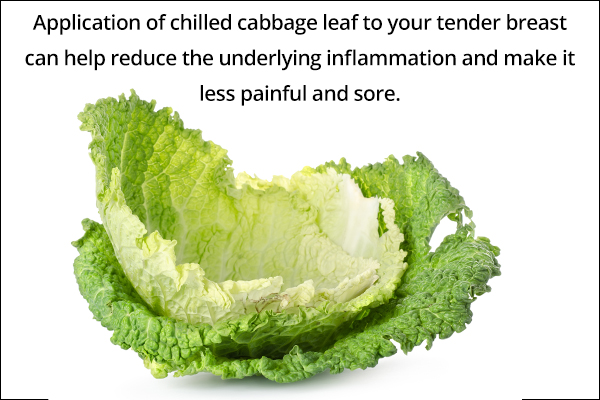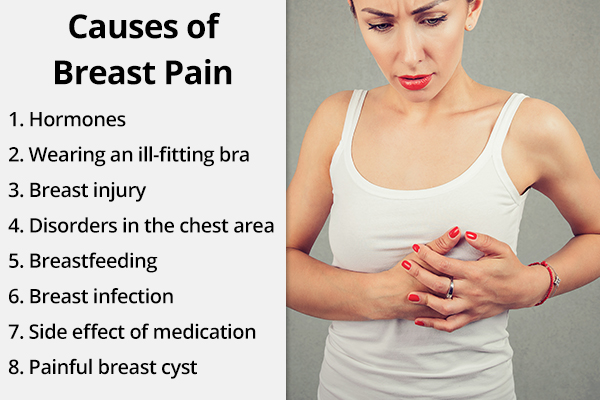In this article:
Breast pain, tightness, or tenderness is quite common among women of reproductive age (1) and can sometimes affect older women too. In rare cases, men can also suffer from this condition.

It is medically referred to as mastalgia and is mostly benign. This article will discuss the types, causes, and symptoms of this condition as well as ways to manage it.
Remedies to Manage Breast Pain
The initial step in the management of breast pain is to search for its cause and focus on reducing the pain with conservative treatment.
The remedies are as follows:
1. Use hot and cold compresses
The alternate application of hot and cold temperatures can help soothe your breast discomfort. The heat stimulates blood flow in the area to curb the underlying inflammation while the cold numbs the underlying nerves to make you feel less pain.
This combination therapy may provide instantaneous relief, but the results are only temporary. It’s recommended to do it at bedtime so that you can get a good night’s sleep.
2. Try relaxation therapy
Relaxation therapy involves deep breathing, meditation, yoga, and other calming activities that can help relieve the anxiety and depression associated with mastalgia.
Stress can trigger unwanted hormonal changes that can aggravate breast pain and inflammation. Thus, stress management is important to keep mastalgia under control. (1)
3. Fix your diet

There is a possibility that certain nutritional factors can trigger or exacerbate breast pain, but they are not directly responsible for it. (2) Thus, certain dietary modifications may help reduce the frequency and severity of mastalgia. These include:
- Limit or eliminate caffeine: This dietary intervention is particularly recommended for relieving premenstrual breast discomfort and has reportedly benefitted a few women, but it can take 6 months or more to show results. However, there aren’t enough studies to establish a conclusive link between giving up caffeine and breast pain reduction. That said, there is no harm in trying since there are virtually no side effects.
- Eat less fat: Fatty foods, especially those loaded with trans and saturated fats, increase estrogen levels in the body, which are linked to breast pain and inflammation. Thus, cutting down your fat intake may help reduce estrogen levels and thereby ease breast pain and lumpiness.
- Reduce salt: Sodium also increases inflammation in the body and can make your breasts heavy, painful, and tender. Thus, consider reducing your intake of salt as well.
- Avoid animal-based foods: Eat less meat and dairy products, both of which contain estrogen that can contribute to mastalgia.
- Foods to eat: Include more fish, tofu, nonfat dairy, and complex carbohydrates in your daily diet. (3)
4. Take evening primrose oil and vitamin E
Medicinal intake of 200 IU of vitamin E two times a day along with 3 grams of evening primrose oil for 3 months was found effective in gradually reducing cyclical breast pain. (1)
Vitamin E is a strong antioxidant that helps reduce breast inflammation and promote fast tissue repair. Meanwhile, evening primrose oil contains gamma-linolenic acid (GLA), which inhibits the release of certain lipid compounds called prostaglandins that act like hormones and are involved in the inflammatory response.
Evening primrose oil not only reduces inflammation in the breast tissue but also keeps it properly lubricated, thus relieving mastalgia discomfort. You can even use it topically to soothe your breast pain and inflammation, but it is most effective when taken orally.
Note: Stop using this remedy if it does not yield any noticeable improvement even after 4–6 months.
5. Use a cabbage leaf

The application of chilled cabbage leaf to your tender breast can help reduce the underlying inflammation and make it less painful and sore.
This remedy is particularly useful for relieving breast engorgement in lactating women as it may help curb swelling and stimulate milk flow. It basically works like a cold compress, although applying the leaf at room temperature is known to be helpful as well.
How to use:
- Wash a fresh cabbage leaf. You can stash it in the refrigerator for a while to get a cooling effect, but this is optional.
- Wrap the leaf around the affected breast.
- Do this 2–3 times a day for maximum relief. (4)
Types of Breast Pain
Mastalgia is classified into two types:
- Cyclical: This is the most prevalent form of breast pain that coincides with your menstrual period. It comes and goes monthly, usually starting just before or during your period. The pain may range from mild to severe and is linked to hormonal fluctuations brought on by menstruation.
- Noncyclical: This type of breast pain is not associated with your menstrual period and does not follow any set pattern of occurrence. It may persist for many weeks or even months and mainly affects women who are nearing or have undergone menopause. (1)(5)(6)
Causes of Breast Pain
Some common causes of breast pain include:

1. Hormones
Menstruation-related hormonal fluctuations are the leading cause of mastalgia in women. (7)
There is generally a spike in female sex hormones, namely, estrogen and progesterone, before the onset of your menstrual period. These hormones cause inflammation in the breast tissue, causing pain, tightness, and tenderness.
The discomfort tends to go away once the period ends.
2. Wearing an ill-fitting bra
A loose bra does not provide proper support to your breasts, causing them to sag and hurt, especially during exercise or other strenuous physical activities.
Conversely, a bra that is too tight will squeeze your breasts and make them sore and painful.
3. Breast injury
Damage, injury, or trauma to the breast tissue can cause inflammation and pain. The discomfort usually subsides as the tissue heals.
But medical attention is needed if you experience:
- Extreme breast pain that does not wane despite proper care
- A lump in the painful breast
- Severe swelling, redness, and warmth in the affected area, all of which could be signs of an infection
4. Disorders in the chest area
Sometimes what you perceive as breast pain is actually originating from your chest wall. This can be due to a physical blow to the chest, tearing or pulling of chest muscles, inflammation surrounding the ribs, or a fractured bone in the area.
5. Breastfeeding
Breastfeeding can make your breasts hurt and sore. This is usually the case when the milk is not being properly expelled such that it backs up in the breast duct, causing heaviness, swelling, and pain.
This could happen for many reasons, the most common culprits being incorrect latching technique and nursing position. Plus, the constant suckling and even biting by the baby can render your nipples dry, cracked, and tender.
If you are suffering from breast discomfort during your lactation period, it’s best to consult your doctor for advice.
6. Breast infection
Lactating women often develop breast infections due to incomplete emptying of the breast duct. The buildup of milk inside the duct and mammary glands creates a warm and humid environment that is ideal for the growth of infection-causing bacteria.
In such cases, breast pain is usually limited to one breast and is accompanied by fever, redness, swelling, warmth, and fluid discharge from the nipple. Seek medical help if you develop such symptoms.
7. Side effects of medication
Certain medications can trigger hormonal changes that may lead to breast pain.
8. Painful breast cyst
If your breast hurts and you can feel a tender lump inside it, you may have a cyst. These fluid-filled lesions are generally benign and self-resolving, but it’s best to get a proper checkup to rule out the risk of cancer.
9. Breast cancer
Breast cancer is usually a silent disease, which means it is mostly painless. However, some cases of breast cancer are inflammatory and are characterized by pain, swelling, redness, heaviness, and discoloration in the affected breast. (8) These symptoms tend to have a sudden onset and rapid progression.
This aggressive form of breast cancer accounts for 1%–5% of all breast cancer cases in the United States.
Symptoms of Mastalgia
The predominant symptom of mastalgia is pain in the breast area that may:
- Vary in intensity from time to time and patient to patient
- Affect one or both breasts
- Be limited to one spot or affect the entire breast (9)
The pain can manifest differently in different patients. Some people experience a dull, aching pain, whereas others get a sharp stabbing pain. The pain may be accompanied by swelling, heaviness, tightness, tingling, or burning sensation in and around the breasts. (10)
Treatment for Breast Pain

The treatment for mastalgia largely depends on its underlying cause, but the following medications are commonly used to provide symptomatic relief from pain and inflammation:
Over-the-counter medications
Topical nonsteroidal anti-inflammatory drugs (NSAIDs) are often recommended as the first-line treatment for mastalgia. This is a relatively safe intervention that is readily available at most pharmacies without a prescription.
Make sure to take these medications in the proper dosage to minimize adverse effects. By and large, their benefits outweigh their risks.
Prescription medications
Danazol, tamoxifen, and goserelin are strong medications that can help alleviate breast pain, but all of them are associated with grievous side effects. For that reason, they are not sold over the counter and can only be prescribed by a doctor. (11)(12)
Diagnosis of Breast Pain or Tenderness
The following diagnostic tools may be used to determine the root cause of breast pain:
- A mammogram, which refers to an X-ray of the breasts that highlights any lumps or abnormalities inside the breast
- A breast ultrasound, which involves using sound waves to create an inside picture of the breast and detect lumps or other abnormalities
- A breast biopsy, which involves surgically extracting a tiny piece of the breast tissue to be examined under a microscope. This is usually a painless procedure that is performed in the outpatient setting to rule out the risk of cancer and other such serious threats. (13)
Prevention of Breast Pain
The following measures may help minimize breast pain or prevent it altogether, but more research is needed to determine just how effective they truly are.
- Avoid hormone replacement therapy and oral contraceptives as much as possible. Both increase estrogen levels, which can trigger or worsen breast pain. Ask your doctor for safer alternatives.
- Wear a properly fitted bra that provides ample support to your breasts. If you are going jogging, running, or performing other athletic activities, put on a sports bra to keep your breasts in place as you move about.
- Lifting heavy weights can pull or damage your breast muscles and cause pain, especially if done frequently or for long durations. Avoid that.
- Quit smoking as it is a contributing factor to breast pain.
- Take an over-the-counter analgesic such as acetaminophen or an NSAID such as ibuprofen to manage severe pain and inflammation, but don’t make a habit out of it. Also, ask your doctor about the appropriate dosage because long-term use of these medications can damage your kidneys and liver and can lead to other deleterious side effects. (14)
When to See a Doctor
Breast pain affects most women throughout their lifetime and is generally not a cause for concern.
However, some cases may be more serious and require medical treatment. Plus, there is always the risk of breast infection and breast cancer, so it’s highly recommended to consult a doctor if you notice any worrisome symptoms.
Here are a few warning signs to look out for, and seek medical evaluation if you notice any of them:
- Lump in the breast that may or may not be painful (8)
- Persistent breast pain that doesn’t subside even after your menstrual period
- Nipple discharge
- Breast pain that is not due to a known condition
- Breast pain accompanied by fever, redness or tenderness, or fluid discharge, which points to an infection (15)
Final Word
Most cases of breast pain are caused by benign conditions that can be safely treated at home or in the primary care setting. (16)
But despite being one of the most common discomforts affecting a majority of women, often repeatedly, mastalgia remains a gravely under-researched condition. (17) More studies are needed to understand its causes and explore interventions to manage it.
The above-listed interventions can go a long way in reducing both the occurrence and severity of breast pain.
- Was this article helpful?
- YES, THANKS!NOT REALLY


